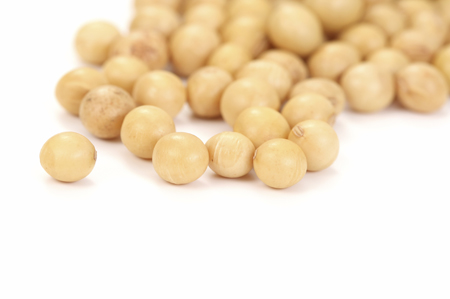AM Markets: Analysts Prefer Soybeans, But Investors Not
Category: Oilseeds
 (Agrimoney) – Modest gains were the order of early deals in ag markets.
(Agrimoney) – Modest gains were the order of early deals in ag markets.
This time, however, it was wheat and corn which outperformed soybeans, arguably against the run of commentator talk on which contract has the most supportive fundamentals.
On points, soybean futures are seen as having the most bullish (lest bearish) prospects for both demand and supply reasons, the former including an easing off in upbeat talk on US harvest yields.
“Twittersphere continues to talk about US soybean yields drifting lower as harvest moves to later-planted beans,” said Benson Quinn Commodities.
At Futures International, Terry Reilly said that “the combination of cold temperatures and precipitation is not favourable for late crop maturation and harvesting”.
Yield estimates
While analysts are lifting soybean estimates, ahead of the US Department of Agriculture’s Wasde crop report next week, the fresh forecast are not as large, relative to the official one, as for corn.
On Thursday, for instance, Informa Economics raised its soybean yield estimate by 0.6 bushels per acre from last month to 50.0 bushels per acre, taking it just 0.1 bushels per acre ahead of the USDA estimate.
Lanworth raised its estimate by 0.5 bushels per acre to 49.3 bushels per acre, below the USDA forecast.
However, on corn, both were ahead of the USDA’s 169.9 bushels-per-acre figure, with Informa coming in at 170.5 bushels per acre and Lanworth at 171.3 bushels per acre.
‘Beans have a friend’
Then there are the Brazilian dryness worries, which remain live, in cutting prospects for a successful sowing season.
“Weather forecasters expect dry soybean regions in Mato Grosso, Brazil to remain that way for another week or so,” said Tobin Gorey at Commonwealth Bank of Australia, terming it issue “supportive” for prices, if not one worth of sparking a rally “for now”.
And there are the demand ideas to factor in, in which soybeans are also outperforming corn and wheat, in terms of US export sales.
“The market needs to attract more corn and wheat business. Beans have a friend in China,” said Benson Quinn Commodities.
CBA’s Mr Gorey said that for wheat, “US export sales continue to be so so”.
‘Basis firming’
CHS Hedging, meanwhile noted that “soybean basis has been seen firming at US Midwest river terminals as barge freight continues to slip lower”, after the rally spurred by lower river levels which put a squeeze on traffic.
“Rainfall and greater availability of empty vessels has helped ease the flow of river traffic.
“Soybean bids were seen gaining as much as $0.14 per bushel on the Mississippi River system.”
Investor spreads
All in all, “demand and Brazilian weather are keeping a floor of support under the bean markets”, said Benson Quinn Commodities.
However, Chicago soybean futures for November added just 0.1% to $9.69 a bushel as of 09:40 UK time (03:40 Chicago time), compared with a 0.2% gain to $3.50 ¼ a bushel in corn for December.
Chicago wheat futures for December added 0.4% to $4.42 ¼ a bushel.
Whether this was down to pre-weekend profit-taking on some grains vs oilseeds bets…
“The funds have a growing short corn and wheat, long beans spread working,” Benson Quinn Commodities said.
Aussie prices
It was also helpful for Chicago wheat futures that prices in Sydney overnight pulled out of their decline, rising by 0.8% to Aus$280.00 a tonne for January delivery, back just ahead of their 20-day moving average.
That left them flat for the week, albeit down 5% from a late-September high, before rains eased eastern Australian crop dryness fears somewhat.
In fact, Sydney futures retain a hefty weather premium, with CBA’s Tobin Gorey saying that they “remain well above export levels, so they will need to fall more than Aus$50 a tonne to be competitive even to destinations nearest Australia”, although on the ground, the premium does vary by region.
‘Frost and possible freezes’
Weather is in focus in the US too, in part in temperatures terms.
“It will get very cold next week across the northern Plains and a big part of the upper Midwest,” Futures International’s Terry Reilly said.
“Frost and possible freezes could occur,” although he added that “no damage to the immature late crop is expected”.
However, rains are a factor too, both short-term, with some Midwest areas seeing late-week rains, while Hurricane Nate is expected to bring downpours to some eastern areas in particular early next week.
While a setback for fieldwork, including row crop harvesting, moisture is needed in soft red winter wheat growing areas of the Midwest in particular.
Hurricane considerations
Of course, Hurricane Nate is also being especially closely watched in the cotton market, given that the US cotton belt is sited along the south and east coastal strip, and so tends to take the brunt of such storms – as it has already done with Harvey and Irma.
Still, “model projections of rainfall from the storm are now much less worrisome” for cotton growers, Mr Gorey said.
The latest National Hurricane Center projection has cut the severity of Nate, and taken its path further west, deemed less threatening for US cotton output overall.
Nate is seen “sparing at least for now the second largest cotton growing state of Georgia and a crop that is open and vulnerable”, said Ron Lee at McCleskey Cotton.
The current projected itinerary, up through Louisiana,Mississippi and Albama “would likely spare the US cotton crop from much damage as there just isn’t a whole lot of cotton in the eye of the current path,” Mr Lee said.
“The northern Alabama crop is still largely unopened and would not be too adversely affected.”
New York cotton for December traded all of 0.01 cents higher at 68.289 cents a pound.




